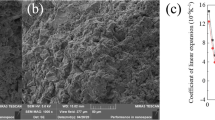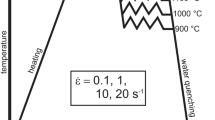Abstract
Superplastic alloys, such as Ti–6Al–4V, are a group of polycrystalline materials which can undergo large elongation in special conditions. By this specific characteristic, superplastic forming can be carried out to manufacture products with complicated shapes. Superplastic forming, in comparison with other similar processes, has a good capability to produce parts with uniform thickness; however, in superplastic blow forming, the final part does not have a uniform thickness distribution, and the prediction of the part thickness has a great significance to the process designers. Numerical methods are used to predict thickness distribution in final part and to improve it by suggesting a precise pressure–time diagram. In this regard, the constitutive equation plays a significant role in predicting the process performance. In the present study, superplastic blow forming has been simulated for a cone-shaped part via using commercial finite element code Abaqus and implementation of a proper constitutive equation by user subroutine UMAT. The constitutive equation considers grain growth hardening effects in addition to strain rate effect. A new method is also proposed to predict pressure–time diagram when UMAT subroutine is used. The effects of the process parameters on this diagram have also been investigated. Comparison between the findings of this research and those conducted by other researchers revealed that considering grain growth hardening has a significant role in the improvement of the accuracy of thickness distribution predictions.









Similar content being viewed by others
References
Backoften WA, Turner JR, Avery DH (1964) Superplasticity in an aluminium-zinc alloy. ASM Trans Q 57:980
Bonet J, Gil A, Wood RD, Said R, Curtis RV (2006) Simulating superplastic forming. Comput Methods Appl Mech Eng 195:6580–6603
Cáceres CH, Wilkinson DS (1984) Large strain behaviour of a superplastic copper alloy deformation. Acta Metall 32:415–422
Carrino L, Giuliano G, Palmieri C (2003a) On the optimisation of superplastic forming processes by the finite-element method. J Mater Process Technol 143–144:373–377
Carrino L, Giuliano G, Napolitano G (2003b) A posteriori optimisation of the forming pressure superplastic forming processes by the finite element method. Finite Elem Anal Des 39:1083–1093
Chen Y, Kibble K, Hall R, Huang X (2001) Numerical analysis of superplastic blow forming of Ti–6Al–4V alloys. Mater Des 22:679–685
Cheong BH, Lin J, Ball AA (2000) Modelling of the hardening characteristics for superplastic materials. J Strain Anal Eng Des 35(3):149–157
Chong-yang G, You-tong F (2005) Investigation on the factors influencing the thickness distribution of superplastic-formed components. J Zhejiang Univ SCI 6A(7):711–715
Dunne FPE (1998) Inhomogeneity of microstructure in superplasticity and its effect on ductility. Int J Plast 14(4–5):413–433
Dunne F, Petrinic N (2006) Introduction to computational plasticity, 2nd edn. Oxford University, Oxford
Dutta A, Mukherjee AK (1992) Superplastic forming an analytical approach. Mater Sci Eng A 157:9–13
Farzin M, Jafari Nedoushan R, Mashayekhi M (2011a) Simulation of hot sheet metal forming processes based on a micro-structural constitutive model. Key Eng Mater 473:556–563
Farzin M, Jafari Nedoushan R, Mashayekhi M (2011b) Simulation of super-plastic forming based on a micro-structural constitutive model and considering grain growth. Key Eng Mater 473:610–617
Ghosh AK, Hamilton CH (1979) Mechanical behavior and hardening characteristics of a superplastic Ti–6AI–4V alloy. Metall Trans A 10:699
Ghosh AK, Hamilton CH (1986) Superplastic forming and diffusion bonding of titanium alloys. Sci J 36(2):153–177
Guo ZX, Ridley N (1989) Modelling of Superplastic bulge forming of domes. Mater Sci Eng A 114:97–104
Hambli R, Potiron A, Guerin F, Dumon B (2001) Numerical pressure prediction algorithm of superplastic forming processes using 2D and 3D models. J Mater Process Technol 112:83–90
Hamilton CH, Ghosh AK (2006) Superplastic sheet forming. In: Semiatin SL (ed) ASM handbook volume 14B, Metalworking: sheet forming. ASM International, pp 345–366
Hwang YM, Lay HS (2003) Study on superplastic blow-forming in a rectangular closed-die. J Mater Process Technol 140:426–431
Hyde KB, Bate PS (2005) Dynamic grain growth in Al–6Ni: modelling and experiments. Acta Mater 53:4313–4321
Jafari Nedoushan R, Farzin M, Mashayekhi M (2012) Dorel Banabic “A micro-structural constitutive model for superplastic forming”. Metall Mater Trans A 43:4266–4280
Jafari Nedoushan R, Farzin M, Banabic D (2014) Simulation of hot forming processes, using cost effective micro-structural constitutive models. Int J Mech Sci 85:196–204
Jarrar FS, Hector LG Jr, Khraisheh MK, Bower AF (2010) New approach to gas pressure profile prediction for high temperature AA5083sheet forming. J Mater Process Technol 210:825–834
Jovane F (1968) An approximate analysis of the superplastic forming of a thin circular diaphragm. Int J Mech Sci 10:405–427
Khaleel MA, Zbib HM, Nyberg EA (2001) Constitutive modeling of deformation and damage in superplastic materials. Int J Plast 17:227–296
Kim B-N, Hiraga K, Sakka Y, Ahn B-W (1999) A grain-boundary diffusion model of dynamic grain growth during superplastic deformation. Acta Mater 47:3433–3439
Lin J (2003) Select of material models for predicting necking in superplastic forming. Int J Plast 19:469–481
Lin J, Dunne FPE, Hayhurst DR (1996) Physically based temperature dependence of elastic-viscoplastic constitutive equations for copper between 20 and 500 °C. Philos Mag A 74(2):359–382
Naeini HM, Maerefat M, Soltanpour M (2005) Finite element simulation of hot forming process by using flow stress prediction model, Iranian. J Sci Technol Trans B Eng 29(B2):231–240
Nazzal MA, Khraisheh MK, Darras BM (2004) Finite element modeling and optimization of superplastic forming using variable strain rate approach. JMEPEG 13:691–699
Odenberger E-L (2005) Material characterisation for analyses of titanium sheet metal forming, Licentiate thesis, Department of Applied Physics and Mechanical Engineering Division of Solid Mechanics, Luleå University of Technology
Pilling J, Ridley N (1989) Superplasticity in crystalline solids. The Institute of Metals, London
Rabinovich MK, Trifonov VG (1996) Dynamic grain growth during superplastic deformation. Acta Mater 44:2073–2078
Rofman OV, Bate PS (2010) Dynamic grain growth and particle coarsening in Al–3.5Cu. Acta Mater 58:2527–2534
Rosserd C (1966) Rev Met 63:225
Tao J, Keavey MA (2004) Finite element simulation for superplastic forming using a non-Newtonian viscous thick section element. J Mater Process Technol 147:111–120
Wang ZR, Xu YW (1989) Advances in constitutive laws for engineering materials. China, p 439
Xing HL, Zhang KF, Wang ZR (2004) A preform design method for sheet superplastic bulging with finite element modeling. J Mater Process Technol 151:284–288
Author information
Authors and Affiliations
Corresponding author
Rights and permissions
About this article
Cite this article
Sheikhalishahi, H., Rasouli, M.A. & Jafari Nedoushan, R. Improving the Prediction of Part Thickness in Superplastic Forming Process of Ti–6Al–4V Alloy Using an Appropriate Constitutive Equation. Iran. J. Sci. Technol. Trans. Mech. Eng. 40, 69–75 (2016). https://doi.org/10.1007/s40997-016-0006-8
Received:
Accepted:
Published:
Issue Date:
DOI: https://doi.org/10.1007/s40997-016-0006-8




